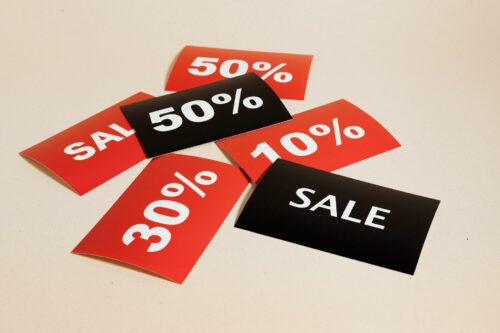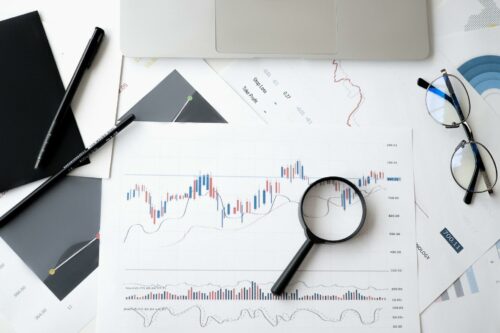How to Calculate the Costs of Goods Sold
Sept 2022
Accountancy for startups and SMEs can be difficult at the best of times. And it only gets worse when your finances aren't in check, for example, when calculating your cost of sales. This guide is here to help.
You’re not just running a business, you’re also juggling finances that both define your business plans and carry huge fines if you make a mistake. So how will you fill in your tax return if you don’t know how to calculate the costs of goods sold? And how do you make sure you've included all of your cost of sales?

It’s a simple example, but too many startups get caught up in the world of accountancy. The numbers and acronyms are a myriad and if just one number has been calculated incorrectly, then like a house of cards, the rest of the calculations fall into tatters. It’s the primary reason why 20% of businesses fail within their first two years!
That’s why accounting for startups and SMEs must be taken seriously. Let’s examine how to calculate the costs of goods/services sold so that you can run your business like a tight ship.
Do all businesses need to know how to calculate the cost of sale?
If your business sells products, then you need to understand the costs involved. End of story. This includes the costs of goods sold (COGS), the cost of sales (COS) and many, many more.
For businesses that don’t sell products, things work slightly differently. You’ll more likely be looking at operating expenses. But, it’s always recommended that you check with an accounting expert for your situation.
The costs of goods sold, however, is essential for eCommerce startups. It’s one section on your tax return that you can’t afford to miss.

Why are the costs of goods sold important?
It’s tempting to skip over calculating the costs of goods sold, but don’t. They’re one of the most important calculations you can make for several reasons, and they lead to more important overall figures.
The following reasons highlight why it’s so essential to calculate the cost of sales.
Calculate gross profit margin
If you’re a small business owner, your gross profit margin is one of the most important KPIs to understand. The good news is, that you only need two figures to calculate it. Your revenue and your COGS.
Your gross profit margin shows exactly how much money you have after paying for the products sold. That margin must cover your operating expenses and is generally an excellent marker of the financial health of your business.
Define direct and indirect costs
If you’re not sure what classes as a direct cost and an indirect cost, then you should contact an accounting expert. However, by separating out your COGS you can help differentiate the two cost classifications.
Did you have to pay for it to make the sale of a product? Then it’s a direct cost. If it’s a monthly cost that you would pay regardless of whether you made the sale or not, then it’s an indirect cost.
Make pricing decisions
Do you lower your price in an attempt to increase sales? What if that lower profit margin doesn’t make enough to cover your costs? Pricing is tricky at the best of times.

If you calculate the costs of goods sold, you can approach pricing in an entirely different way. You’ll see an exact figure of how much it costs to sell your product or service. You can then estimate the volume of sales necessary to cover your operating expenses. If that volume is obscenely large, then you may need to raise your prices.
How to calculate the cost of goods sold
But let’s get down to the real business - what’s the formula for calculating the costs of goods sold?
(Starting inventory + purchases) - ending inventory = COGS
This not only gives strict time periods to define your COGS, but also shows the exact costs relating to acquiring, manufacturing and assembling your products along the way.
For example, you have a business printing t-shirts. You begin the year with £3,000 of inventory. Throughout the year, you purchase £10,000 to supplement your business and end the year with £2,000 of inventory left.
Your COGS would be (3,000 + 10,000) - 2,000 = £13,000.
If your revenue made throughout the year is not larger than your COGS, then no profits have been made within that period, let alone to cover your operating expenses!
Remember, this formula is a rate of profits related to your direct costs of sales, not to the costs of your entire business. It’s absolutely vital within your business calculations, but by no means the only calculation.

What costs are included in COGS calculations?
Everything that relates to the process of either creating your products (by whatever means) or by making the sale. We’ve put together a small list of examples of direct costs that should be included in your cost of goods sold calculations.
Direct costs could include:
Raw material
Packaging
Labour
Freight in costs
Items purchased for resale
Payment processing fees
Utilities
Rent
Indirect costs that may also be included in your COGS could be:
Office supplies
Equipment rental
IT
However, you shouldn’t jump to conclusions just yet. While your costs of goods sold will include a mixture of direct and indirect costs, not all of them will apply to your cost of goods sold.
This can vary depending on your industry, your products and whether or not they classify as operating expenses. It’s why it is vital that you contact an accountancy expert to get advice for these sorts of classifications.
Don’t let cash flow become a problem!
The difference between COGS and operating expenses
As previously mentioned, if you paid for something that was specifically required to make the sale of your product, then it should go on COGS. If they were costs required for the day to day running of your business, then they’re operating expenses.

Operating expenses is generally used to include selling, general and administrative expenses, but most of the time you can include them under operating expenses. Examples of these costs can include:
Rent (not related to manufacturing)
Utilities (not related to manufacturing)
Property taxes
Business travel
Accounting expenses
Legal expenses
Advertising and promotional materials
Marketing expenses
Corporate & administrative salaries
These items can’t be directly linked to the acquiring, assembling or manufacturing of products and therefore can’t be included in your COGS calculations.
To be better safe than sorry, your operating expenses are any cash outflow that is not applicable within your COGS.
4 methods to aid your costs of goods sold
Your business costs are constantly dynamic. These can fluctuate based on supply & demand, depreciation, pricing and much more. Eventually, your individual product prices can end up damaging your cost of goods sold calculations.
Older inventory taking up space for long periods will negatively affect your COGS formula - so what can you do to prevent it?

Well luckily, there are four approaches you can adopt to improve your cost of goods sold calculations.
FIFO
First in, first out. It’s the standard shelf stacking practice for any store and it can help with your business, no matter the sector.
FIFO means that the older products in your inventory need to be pushed out as soon as you can, with a higher priority than your newer products. Since prices tend to increase over time, this translates to you selling cheaper products first. This usually produces a lower COGS and increases your net income over time.
LIFO
In stark difference to FIFO, LIFO stands for last in, first out. With the opposite effect happening, you sell your most expensive products before the cheaper ones. While this can help for an emergency cash injection if required, it leads to a higher cost of goods sold and a net income that decreases over time.
Average cost method
To relieve the pressure of building a priority-based system, the average cost method does away with all of that. Instead, this is based on the average cost of the goods available during the period.
You add up the total costs of all products available and divide that value by the number of products available. This gives you a weighted average unit cost that you can apply within your COGS later.
By failing to define products by their date of manufacture, this average cost method can help smooth out any spikes or outliers that are within your COGS and help create a more average amount.

Special identification method
More complex and more specific, the special identification method foregoes any average calculations and takes each product as it is. This accounting method tracks each and every item that is produced and passes through your inventory.
Products are listed with their respective costs included, for example, products X, Y and Z cost £11, £17 and £22 respectively. The cost of each particular unit is used to denote your COGS at the end of each period and helps bosses identify exactly what was sold and at how much of a cost.
Step by step walkthrough to calculate your cost of goods sold
We’ve given the necessary information, recommendations and advice, but we can still talk you through your COGS. Let’s go from start to finish!
Step #1 - identify direct & indirect costs
As we said before, things can be tricky and we highly recommend dedicated accountancy services to help define exactly what counts as COGS and what falls under operating expenses. Whether you manufacture or resell, just remember:
Direct Costs: Relate to production or purchase of your product
Indirect Costs: Warehousing and labour of your product
Step #2 - determine facility costs
Whether it’s rent, mortgage, utilities or other costs, your facility costs play a vital part in determining your COGS. The question is - how much of the costs are directly related to production of your goods? Is it 8% or 80%?
This is where a qualified tax professional comes into play. An experienced accountant can calculate and justify the proportion of facility costs that go into calculating your cost of sales.
Step #3 - identify your beginning inventory
Your beginning inventory should match your previous ending inventory, but it’s always necessary to double check. Items to be listed include:
Work in progress
Raw materials
Finish products
Supplies

It’s easier if you perform running inventory and double-check every week throughout the year. If your beginning inventory has a discrepancy from your previous ending inventory then an explanation must be provided.
Step #4 - collate purchases of inventory items
This matter *should* be taken care of by regular additions of inventory throughout the entire year. Each manufacturing cost should be accurately input into your records and it will be a simple matter of adding up the information.
If you have purchased products to be resold, then make sure the invoices and other paperwork are recorded and saved electronically to make your COGS calculations easier.
Step #5 - identify ending inventory
If you have kept a running record of your inventory throughout the year, then this number should be more or less accurate. However, you do need to be careful of damaged, unsellable or otherwise compromised items.
It’s always recommended to do a physical check of all of your items and make sure there are no discrepancies. You can lower your ending inventory by reporting obsolete or damaged items. Damaged items require an estimated value, worthless inventory must be destroyed (with evidence of destruction) and out of date inventory must show an (estimated) decrease in its value.
Calculate your COGS value
Plug your figures into the formula and you’re done! But by no means is that the end. In fact, your work is just beginning as you launch into more accountancy problems, calculations and acronyms while simultaneously keeping an eye on your business.

Kick the confusion with accountancy services designed for startups! Our dedicated team of Tax Experts, CFOs and R&D Tax Specialists are on hand to help you with your accountancy problems.
You can gain professional services at a fraction of the price of maintaining in-house experts. Not only that, but you’ll also receive our award winning bookkeeping software. A single comprehensive platform that covers all of your accounting needs. Everything including reports, payroll, cashflow, invoices, expenses and more is available with a few keystrokes.
Talk to a financial specialist today and learn about how you could save money and plan your business future. With our help, you can save up to scale up in no time! Remember to sign up for our School of Startups to get first hand advice from experts in the business world!
#1 finance partner for tech & e-commerce startups
- 100% online
- All in one accountancy, R&D and CFO services
- 9/10 customers recommend us

Educational content just for startups. As a member, you’ll get unlimited access to an extensive range of guides, blogs and advice to help you run and grow your business.


